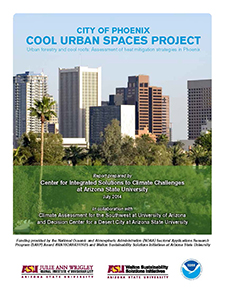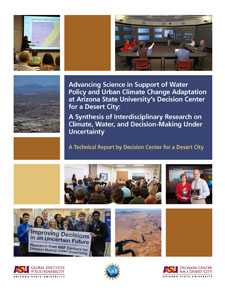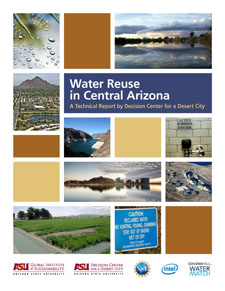Decision Center for a Desert City produces technical papers to provide an authoritative guide on subjects related to water sustainability and urban climate adaptation. DCDC Policy Briefs provide a concise summary of a particular issue, the policy options to deal with it, and some recommendations on the best options.
2018
An Assessment of Water Sustainability Indicators for the Colorado River Basin
Background
Water is essential to human settlements and an essential concept of water sustainability is that over the long-term water supply cannot be lower than water demand needed to sustain human settlement and environmental needs. In order to maintain sustainable water systems in an environment of constant change, practices and policies are needed to manage supplies and demands in order to adapt to changing conditions over time. Every time a new public policy is enacted to solve some problem, it is an attempt to predict the impact this policy will have on the future state of social and natural systems. The reality is that when policies are enacted and implemented, there is no guarantee the result will be to increase water sustainability. Thus, evaluation is a critical aspect of planning for water sustainability. This will require us to measure the current or estimate the future state of water sustainability.
This report provides an annotated set of current academic and professional indicators that can be used to assess the water sustainability of the Colorado River Basin, and identifies the needs for professional development and academic research to further define and enhance an effective water sustainability indicator system for the Colorado River Basin. The review examined 22 different sets of water sustainability indicator frameworks with 250 specific indicators identified. Each indicator was assessed against a Sustainability Assessment Framework derived from six published sustainability frameworks. Each indicator was also assessed as to its advantages and limitations based on data sources, type and time frame, scope, and critiques. Finally, an assessment of general indicator credibility, salience, and legitimacy as well as needs for further research is presented.
Read the report ASU An Assessment of Water Sustainability Indicators for the Colorado River Basin.
2018
Assessing the connection between Land Use Planning and Water Resource Planning
Background
Water sustainability is not a static state for which one can measure the balance between supply and demand and declare that balance has been or has not been achieved. Human water needs are going to be defined in terms of quality of life and will be different for different people, different regions, at different points in time. Water supplies are not static, but change over time and for different places. Water sustainability will be dynamic over time in terms of its definition and state. What we need to assess sustainability is a set of metrics that can assess the state of water sustainability from multiple viewpoints over time.
When assessing the level and effectiveness of polices that integrate land use planning and water planning processes, the outcomes of change we are ultimately interested in are not changes in the relationship, rather changes in the state of water sustainability. Furthermore, we are interested in assessing to what degree the changes in water sustainability can be attributed to changes in the relationship. Thus, such assessment will have three components:
- To what degree is there currently coordination between land use and water planning?
- To what degree are efforts to increase coordination resulting in more coordination?
- To what degree is increased coordination between land use and water planning changing water sustainability?
This project attempts to address a specific aspect of items 1 and 2 above.
Read the report ASU Lincoln Report FINAL Assessing The Connection Between Land Use Planning and Water Resource Planning.
2018
Urban Landscape Water Use Research Evaluation
Background
As the balance between urban water supplies and water demand becomes more critical, the focus of the search for additional residential conservation gains has shifted to the landscape sector.
Today, irrigated landscapes are a dominant element in the urban form of most cities, a fact that has received critical national media attention as states from Georgia to California struggle with persistent drought and the need to reduce urban water use to be more in balance with available water supplies. For many communities, the most common response to drought-stressed water supplies is to restrict landscape irrigation. This is not unwarranted in that the majority of households irrigate in some fashion and in some cases inefficient irrigation practices prevail. However, as important as urban landscape water use has become, the empirical investigation of urban landscape water demand and demand management options has had far less focus than indoor water use.
Over the last twenty-five years, there has been a slow growth in literature and program development focused on urban landscape water use. Much of this work on urban landscape water use suggests that findings are not consistent across geographic regions and, in some cases, current prevalent ideas about landscape water use may no longer be warranted.
This report provides academic and professional researchers with a contemporary review of urban landscape water use research.
Read the Water Research Foundation Project #4633 report and Executive Summary.
Access the database Database of Urban Landscape Water Demand Citations.
2014
City of Phoenix Cool Urban Spaces Project
Urban forestry and cool roofs: Assessment of heat mitigation strategies in Phoenix
Prepared by the Center for Integrated Solutions to Climate Challenges at Arizona State University in collaboration with the Climate Assessment for the Southwest (CLIMAS) at the University of Arizona and Decision Center for a Desert City (DCDC).
Executive Summary
The City of Phoenix’s Cool Urban Spaces Report (2014) investigated the impact of the Phoenix Cool Roofs and Tree and Shade Master Plan initiatives on the city. The study evaluated how these heat mitigation efforts affect microclimates and human thermal comfort in the Phoenix metropolitan area. These findings are especially relevant as rapid and extensive urbanization has led to an urban heat island (UHI) effect that has increased steadily at approximately 0.9°F per decade.
 The city’s questions guiding this research were:
The city’s questions guiding this research were:
- What are the cooling benefits achieved by increasing tree canopy from 10% (current) to 25% (2030 goal) and/or implementing cool roofs under existing conditions and projected warming?
- What is the diurnal thermal benefit of tree canopy shade for a typical heat wave day during premonsoon summer?
The impacts of cool roofs and trees on near-ground air temperatures were modeled through 54 scenarios for a typical residential neighborhood in Phoenix. We ran the model for a combination of three treeplanting scenarios (no trees, current canopy cover and 2030 canopy goal) and three landscaping scenarios (mesic, oasis and xeric) with regular roofs and cool roofs under current climate conditions and two climate change projections.
Two significant results of the tree and shade initiative are: (1)increasing tree canopy cover to 25% leads to an additional temperature reduction of 4.3°F, which is a total cooling benefit of 7.9°F as compared to a bare neighborhood, and 2) switching landscaping from xeric to oasis, i.e., adding grass patches to residential backyards, reduces average neighborhood temperatures by 0.4°F to 0.5°F.
The scenario with the lowest air temperatures is the residential neighborhood with mesic landscaping, 25% tree canopy cover and cool roofs under current climate conditions with an average neighborhood temperature of 99.5°F. In contrast, the xeric neighborhood with no tree cover and regular roofs under the high-emissions climate change scenario is the hottest. This indicates that the combination of increased tree canopy cover and cool roofs does lower temperatures as well as reduce the demand for air conditioning, thereby reducing anthropogenic heat. However, trees and cool roofs are only part of the solution and need to be included in a broader, more comprehensive mitigation and adaptation plan.
Across all climate and tree scenarios, the effect of cool roofs alone on local daytime temperatures is relatively low. Air temperature reduction only amounts to 0.5°F in the neighborhood. Regarding the city’s cool roofs initiative, results show little benefit for extending this project to commercial and residential properties based on its cooling impacts alone.
Our research thus far indicates that there is no simple solution to mitigating the UHI, but a complex balance of strategies will be necessary so that efforts to lower the daytime temperatures do not increase nighttime temperatures or shift UHI impacts to more vulnerable populations.
Download the report.2013
Advancing Science in Support of Water Policy and Urban Climate Change Adaptation at Arizona State University’s Decision Center for a Desert City: A Synthesis of Interdisciplinary Research on Climate, Water, and Decision-Making Under Uncertainty
Summary
 The Decision Center for a Desert City (DCDC) at Arizona State University (ASU)—funded by the National Science Foundation (NSF) since 2004—conducts research relevant to water resources and urban climate dynamics under multiple uncertainties. This report summarizes and synthesizes research findings and achievements of DCDC after almost a decade of research and science-policy interactions. Water resource decision-making is complicated by climate change and variability, population growth and economic development, diverse stakeholder interests and fragmented governance. While these factors generate various uncertainties and complexities for decision makers, DCDC pursues research to create a more sustainable future. The DCDC contributes to water management and urban sustainability by conducting basic science and collaborating with policymakers and stakeholders to solve realworld problems. As detailed herein, DCDC research, education, and community outreach have made substantial contributions to improving water-resource governance and climate adaptation.
The Decision Center for a Desert City (DCDC) at Arizona State University (ASU)—funded by the National Science Foundation (NSF) since 2004—conducts research relevant to water resources and urban climate dynamics under multiple uncertainties. This report summarizes and synthesizes research findings and achievements of DCDC after almost a decade of research and science-policy interactions. Water resource decision-making is complicated by climate change and variability, population growth and economic development, diverse stakeholder interests and fragmented governance. While these factors generate various uncertainties and complexities for decision makers, DCDC pursues research to create a more sustainable future. The DCDC contributes to water management and urban sustainability by conducting basic science and collaborating with policymakers and stakeholders to solve realworld problems. As detailed herein, DCDC research, education, and community outreach have made substantial contributions to improving water-resource governance and climate adaptation.
Download the report.
Citation
Larson, K.L., D.D. White, P. Gober, C.W. Kirkwood, V.K. Smith, M.C. Nelson, C.L. Redman, and S.K. Wittlinger. 2013. Advancing Science in Support of Water Policy and Urban Climate Change Adaptation at Arizona State University’s Decision Center for a Desert City: A Synthesis of Interdisciplinary Research on Climate, Water, and Decision-Making Under Uncertainty. Decision Center for a Desert City Technical Report 13-02. Tempe, AZ: Arizona State University.
Water Reuse in Central Arizona
Summary
 There were times when society considered wastewater just what its name suggests — a waste product to be treated and disposed of while minimizing its impact on the environment. While that viewpoint still prevails in some places, communities across the United States are increasingly reclaiming wastewater and considering it a valuable resource. In these communities, the effluent from wastewater treatment plants can relieve the stress on overstretched water supplies by replacing other sources for non-potable, or sometimes even potable, uses.
There were times when society considered wastewater just what its name suggests — a waste product to be treated and disposed of while minimizing its impact on the environment. While that viewpoint still prevails in some places, communities across the United States are increasingly reclaiming wastewater and considering it a valuable resource. In these communities, the effluent from wastewater treatment plants can relieve the stress on overstretched water supplies by replacing other sources for non-potable, or sometimes even potable, uses.
This is particularly true in the arid Southwest, where droughts are a natural part of the climate cycle and water supply is inherently variable and limited. The projected impacts of climate change threaten future water supplies due to reduced precipitation, increased evaporation that follows higher temperatures, increased demand, and decreased water availability from surface water supplies such as the Colorado River. Arizona, for instance, has a long history of reusing water, reaching back to at least 1926 when reclaimed water was used for power generation at Grand Canyon Village.
Today, treated wastewater—or effluent—is being used in Arizona for a variety of beneficial purposes, including agricultural and landscape irrigation, industrial cooling, and groundwater recharge. While estimates of effluent reuse in the state vary, reuse in the Phoenix Active Management Area (AMA) may be as high as 82 percent. Although effluent reuse satisfies only a tiny fraction of overall water demand, there is little excess effluent available. In fact, there is growing tension regarding how to best reuse wastewater to sustain central Arizona for the future. Tradeoffs between people, crops, industry, and recreation must be discussed and decisions must be made.
In much of Arizona, sewer-flow volumes have been stable over the past decade. As a result of declining indoor water use, per capita flows have decreased, but population growth has offset this decrease, resulting in steady overall sewer-flow volumes. During the recent economic recession, sewer flows declined in some of the hardest-hit communities, but there are indications that these flows are returning to previous levels.
If the population in Arizona continues to grow at a rate that offsets any decline in per capita water use, it is expected that effluent production will remain close to today’s levels, at least in the near to midterm future. Given the existing high level of effluent use, it is likely that as surface and groundwater supplies become strained from growth and drought, the competition for the highest and best use of effluent will increase.
In Arizona, the predominant use of reclaimed water is for landscape and crop irrigation with the remaining effluent going to industry, aquifer recharge, and a small amount for environmental amenities like urban lakes, fountains, and wetland restoration. Other potential uses exist, such as a direct or indirect supply for potable use. Drought and climate change may reduce the reliability of surface water supplies and increase the desire to use effluent as a potable water supply. This could create a more competitive environment for effluent between urban, agricultural, and environmental uses.
The cost of effluent could also be impacted by water-quality issues. Increasing salinity of wastewater could eventually require salt-removal methods in order to make it suitable for most current uses. The City of Scottsdale is already using reverse osmosis (RO) to deliver low-salinity effluent to golf courses in north Scottsdale. In the future, wastewater treatment might also have to deal with contaminants of emerging concern (CECs) and pharmaceuticals currently not regulated in effluent.
Lastly, the future use of effluent is affected by public attitudes towards the reuse of wastewater as a source of potable water. Negative public attitudes involving protests and hunger strikes over the use of treated effluent for artificial snow generation have already surfaced in northern Arizona. This controversy is driven not only by environmental concerns, but also by cultural beliefs. How residents feel about wastewater as an indirect or direct source of potable water remains to be seen (see Public Perception of Water Reuse).
These issues raise questions about the role effluent will play in the future of water resources in Arizona. This topic was addressed in detail by the Arizona Governor’s Blue Ribbon Panel on Water Sustainability, but many key issues raised in that extensive report remain unresolved. This report presents case studies and policy briefs of wastewater use and management in Arizona with special focus on central Arizona and the greater Sun Corridor—the central Arizona urban region that includes Phoenix and Tucson. This report continues the conversation that was started by the Blue Ribbon Panel and the Morrison Institute’s Watering the Sun Corridor report. It provides an assessment of effluent reuse to inform public officials, water professionals, and the interested public about the water resource policy implications of effluent reuse.
Based on expert interviews, literature reviews, qualitative analyses, and synthesis of existing scientific research, this report summarizes the status of wastewater production and reuse in the Sun Corridor, and identifies potential constraints on wastewater reuse under the current and predicted future economic and regulatory systems.
The report is organized in the four following sections that address wastewater reuse issues and future implications for central Arizona:
- Section 2 addresses the potential increase in competition for effluent based on a discussion of existing and potential future demands for reclaimed water.
- Section 3 focuses on increased costs and their drivers, including salinity, percentage of solids, removal of pharmaceuticals, and infrastructure.
- Section 4 discusses future implications and describes a new marketplace that may be created for the sale and allocation of effluent in the future; it briefly discusses future uncertainty and our current lack of knowledge about the dynamics of the cost drivers that limit our ability to anticipate the potential consequences of a new effluent marketplace.
- Section 5 presents final thoughts on supporting a policy dialogue on water reuse in central Arizona and concludes with a suggestion of ten research priorities.
Download the report. View Arizona Horizon video with Dave White describing the report.
Citation
Middel, A., R. Quay, and D.D. White. 2013. Water reuse in central Arizona. Decision Center for a Desert City Technical Report 13-01. Tempe, AZ: Arizona State University.

